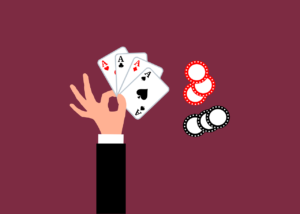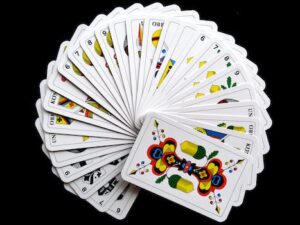Unmasking the Community: Deciphering the Art of Playing with Shared Cards for Unbeatable Poker Triumphs is a comprehensive guide that aims to unravel the intricacies of playing poker with shared cards. This book delves into the strategies, techniques, and mindset required to achieve unbeatable triumphs in the game of poker. By exploring the dynamics of the community cards and understanding how to leverage them effectively, players can gain a significant advantage over their opponents. Whether you are a novice or an experienced player, this book provides valuable insights and practical advice to enhance your poker skills and elevate your gameplay to new heights.
The Importance of Community Cards in Poker Strategy
Community cards, also known as shared cards, are the cards that are placed face-up on the table and can be used by all players to form their best hand. These cards are dealt in stages, with the first three cards known as the flop, followed by the fourth card, known as the turn, and finally the fifth card, known as the river. The presence of these community cards adds an element of unpredictability and excitement to the game, as players must use their skill and strategy to decipher the hidden potential of these shared cards.
The importance of community cards in poker strategy cannot be overstated. These cards have the power to turn a losing hand into a winning one, or vice versa. They can provide players with the missing piece of the puzzle, allowing them to complete a winning hand or improve their existing hand. However, they can also give opponents the opportunity to do the same, making it crucial for players to carefully analyze the potential combinations that can be formed with these shared cards.
One of the key strategies in playing with community cards is to carefully observe the reactions and betting patterns of your opponents. By paying close attention to how they react to the community cards, you can gain valuable insights into the strength of their hand. If an opponent suddenly becomes more aggressive or starts betting more, it could be an indication that they have formed a strong hand with the community cards. On the other hand, if an opponent becomes more cautious or starts checking, it could be a sign that the community cards did not improve their hand as much as they had hoped.
Another important aspect of playing with community cards is to understand the concept of pot odds. Pot odds refer to the ratio of the current size of the pot to the cost of a contemplated call. By calculating the pot odds, players can determine whether it is mathematically profitable to continue playing with their hand. If the potential winnings outweigh the cost of the call, it may be worth taking the risk and playing with the community cards. However, if the pot odds are unfavorable, it may be wise to fold and wait for a better opportunity.
In addition to observing opponents and calculating pot odds, players must also be able to accurately assess the strength of their own hand in relation to the community cards. This requires a deep understanding of poker hand rankings and the ability to quickly analyze the potential combinations that can be formed. By accurately assessing the strength of their hand, players can make informed decisions about whether to bet, raise, or fold, maximizing their chances of success.
In conclusion, the importance of community cards in poker strategy cannot be underestimated. These shared cards have the power to turn the tide of a game, and players must use their skill and strategy to decipher their hidden potential. By carefully observing opponents, calculating pot odds, and accurately assessing the strength of their own hand, players can increase their chances of achieving unbeatable poker triumphs. So, the next time you sit down at a poker table, remember to unmask the community and use its power to your advantage.
Mastering the Art of Reading Community Cards for Better Decision Making
When the community cards are revealed, they provide valuable information about the strength of each player’s hand. By carefully observing these cards and analyzing their potential combinations, skilled players can gain a significant advantage over their opponents. This ability to read the board is what separates the amateurs from the professionals.
The first step in deciphering the art of playing with shared cards is to understand the different types of community cards. There are three main categories: the flop, the turn, and the river. The flop consists of three cards that are revealed simultaneously, followed by the turn, which reveals a fourth card, and finally the river, which reveals the fifth and final card. Each of these stages provides additional information that can be used to assess the strength of one’s hand.
Transitional phrase: Now that we understand the different types of community cards, let’s delve into the strategies for reading them effectively.
One strategy is to consider the possible combinations that can be formed with the community cards. For example, if the flop reveals three cards of the same suit, there is a possibility of a flush. Similarly, if the flop reveals three consecutive cards, there is a potential for a straight. By keeping these possibilities in mind, players can make more informed decisions about their own hand and the hands of their opponents.
Another important aspect of reading community cards is to pay attention to the texture of the board. The texture refers to the overall pattern and composition of the community cards. For instance, a board with low cards and no potential flush or straight draws is considered dry, while a board with high cards and multiple potential draws is considered wet. Understanding the texture of the board can help players gauge the likelihood of their opponents having strong hands.
Transitional phrase: Now that we have covered the strategies for reading community cards, let’s explore how this skill can lead to better decision making.
By effectively reading community cards, players can make more accurate assessments of their hand’s strength relative to their opponents. This allows them to make better decisions about whether to bet, raise, or fold. For example, if the community cards reveal a potential flush or straight, a player with a weaker hand may choose to fold rather than risk losing to a stronger hand.
Furthermore, reading community cards can also help players identify potential bluffs. If the community cards do not support a strong hand, but a player continues to bet aggressively, it may indicate that they are bluffing. By recognizing these bluffing opportunities, skilled players can exploit their opponents’ weaknesses and gain an advantage in the game.
In conclusion, mastering the art of reading community cards is crucial for making better decisions and achieving unbeatable poker triumphs. By understanding the different types of community cards, considering possible combinations, and analyzing the texture of the board, players can gain valuable insights into the strength of their hand and the hands of their opponents. This skill allows them to make more informed decisions and exploit their opponents’ weaknesses. So, the next time you sit down at the poker table, remember to unmask the community and decipher the art of playing with shared cards for a shot at unbeatable triumphs.
Unmasking the Community: Strategies for Exploiting Shared Cards in Poker
In poker, the community cards are dealt face-up on the table for all players to use in combination with their own hole cards. These shared cards, also known as the board, create a dynamic playing field where players must adapt their strategies accordingly. To truly excel in the game, one must possess the ability to exploit the potential of these community cards.
One strategy that experienced players employ is to carefully observe the community cards as they are revealed. By paying close attention to the cards on the board, players can gain valuable insights into the possible hands their opponents may hold. This information allows them to make more informed decisions and adjust their own betting accordingly.
Transitional phrase: Moreover, skilled players understand that the community cards can also be used to deceive opponents. By strategically betting or bluffing, players can manipulate the perception of their hand strength, leading opponents to make costly mistakes. This art of deception is a crucial aspect of poker, and the community cards provide the perfect canvas for such tactics.
Another key aspect of exploiting the community cards is understanding the different types of hands they can create. The most coveted hand in poker is the royal flush, which requires a specific combination of community cards and hole cards. Skilled players know that the chances of landing a royal flush are slim, but they also recognize the potential for other strong hands, such as a straight or a flush, that can be formed with the help of the community cards.
Transitional phrase: Furthermore, the community cards can also dictate the pace of the game. For example, if the board reveals a series of low-value cards, players may be more cautious in their betting, anticipating the possibility of a low-scoring hand. Conversely, if the community cards are high-value, players may become more aggressive, sensing the potential for a strong hand.
One of the most challenging aspects of playing with community cards is the uncertainty they introduce. Unlike the hole cards, which are concealed from opponents, the community cards are visible to all players. This means that even the most skilled players must navigate the game with incomplete information. However, it is precisely this element of uncertainty that adds excitement and intrigue to the game.
Transitional phrase: To navigate this uncertainty, players must rely on their ability to read their opponents’ reactions and betting patterns. By carefully observing how opponents respond to the community cards, players can gain valuable insights into their hand strength and intentions. This skill, known as reading tells, is a crucial component of successful poker play.
In conclusion, the community cards in poker are not merely random additions to the game; they are a canvas for strategic play and deception. Skilled players understand the importance of observing and exploiting the potential of these shared cards. By deciphering the art of playing with community cards, players can unlock the secrets to unbeatable poker triumphs. So, the next time you sit down at the poker table, remember to unmask the community and let the cards guide you to victory.
Analyzing Community Card Patterns for Predicting Opponents’ Hands
In poker, community cards are shared cards that all players can use to form their final hand. These cards are dealt face-up in the middle of the table, creating a common pool of cards for everyone to utilize. Understanding the patterns that emerge from these shared cards can provide invaluable insights into the hands your opponents may hold.
The first step in deciphering community card patterns is to observe the cards as they are revealed. By paying close attention to the sequence and the suits of the cards, astute players can begin to piece together potential combinations that their opponents might be holding. For example, if the first three community cards are all hearts, it is likely that someone at the table has a flush draw or even a completed flush.
Transitional phrase: Moving on to the next aspect of analyzing community card patterns, it is essential to consider the texture of the board. The texture refers to the overall composition of the community cards and how they interact with each other. Is the board coordinated, with cards of consecutive ranks or the same suit? Or is it uncoordinated, with no apparent connections? These factors can greatly influence the range of hands your opponents are likely to have.
A coordinated board, such as 8-9-10 of spades, offers numerous possibilities for straight draws and flush draws. Players with suited connectors or pocket pairs may be enticed to stay in the hand, hoping to complete their draws. On the other hand, an uncoordinated board, like 2-7-K of mixed suits, limits the potential for strong hands. In such cases, players with high-ranking cards or pairs may be more likely to hold a winning hand.
Transitional phrase: Another crucial aspect of analyzing community card patterns is considering the betting actions of your opponents. How they bet and react to the community cards can provide valuable clues about the strength of their hands. If a player suddenly becomes more aggressive after a favorable community card is revealed, it is a strong indication that they have connected with the board in some way.
Conversely, if a player suddenly becomes passive or folds after an unfavorable community card, it suggests that their hand may have weakened. By carefully observing these betting patterns, skilled players can make informed decisions about the strength of their own hand and adjust their strategy accordingly.
Transitional phrase: Finally, it is important to remember that analyzing community card patterns is not an exact science. While it can provide valuable insights, it is still just one piece of the puzzle. Other factors, such as players’ tendencies, table dynamics, and overall game flow, must also be taken into account.
In conclusion, deciphering the art of playing with shared cards is a crucial skill for achieving unbeatable poker triumphs. By observing the sequence, suits, and texture of the community cards, players can gain valuable insights into their opponents’ hands. Additionally, paying attention to betting actions can further enhance their ability to make informed decisions. However, it is important to remember that community card analysis is just one tool in a poker player’s arsenal. Success in the game ultimately relies on a combination of skill, strategy, and a little bit of luck.
Unbeatable Poker Triumphs: Leveraging Community Cards to Dominate the Game
Poker, the quintessential card game of skill and strategy, has captivated players for centuries. From smoky backrooms to glitzy casinos, the allure of the game lies in its ability to blend luck and cunning. While individual cards can make or break a hand, it is the community cards that truly separate the amateurs from the masters.
In poker, community cards are those dealt face-up in the center of the table and shared by all players. These cards, also known as the board, are the key to unlocking the potential of a winning hand. Understanding how to leverage these shared cards is the secret to achieving unbeatable poker triumphs.
The first step in deciphering the art of playing with community cards is to recognize their power. Unlike the hole cards, which are dealt privately to each player, the community cards are visible to all. This means that every player has access to the same information, creating a level playing field. It is how one interprets and utilizes this information that sets the winners apart.
One of the most effective strategies is to carefully observe the community cards as they are revealed. Each card that is added to the board provides valuable clues about the potential strength of opponents’ hands. By paying close attention to the suits and ranks of these cards, astute players can make educated guesses about the hands their opponents may be holding.
The next step is to analyze the possible combinations that can be formed with the community cards. This requires a deep understanding of poker hand rankings and the ability to quickly assess the potential strength of various combinations. By mentally calculating the odds of different hands, players can make informed decisions about whether to fold, bet, or raise.
One popular tactic is to bluff or deceive opponents by capitalizing on the community cards. Skilled players can use the shared cards to create the illusion of a strong hand, even when their own hole cards are less than stellar. By carefully studying the board and making calculated bets, players can force their opponents to fold, securing victory without ever revealing their true hand.
Overreliance on the community cards can lead to complacency and poor decision-making. It is crucial to remember that the shared cards are just one piece of the puzzle. Successful poker players understand the importance of balancing their hole cards with the community cards, using both to their advantage. By maintaining a flexible strategy and adapting to the changing dynamics of the game, players can maximize their chances of triumph.
In conclusion, the art of playing with community cards is a delicate dance between observation, interpretation, and strategy. By recognizing the power of these shared cards and understanding their significance, players can gain a competitive edge in the game of poker. Whether it is using the community cards to bluff opponents or making calculated bets based on the potential combinations, mastering the art of playing with shared cards is the key to achieving unbeatable poker triumphs. The article “Unmasking the Community: Deciphering the Art of Playing with Shared Cards for Unbeatable Poker Triumphs” explores the strategies and techniques involved in playing poker with shared cards. It delves into the intricacies of the game, providing insights on how to decipher the community cards and use them to achieve unbeatable poker triumphs. The article serves as a valuable resource for poker players looking to enhance their skills and improve their chances of success in the game.




